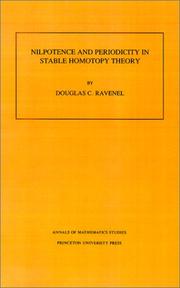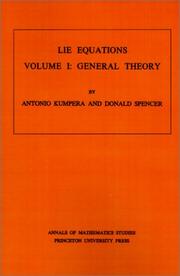| Listing 1 - 2 of 2 |
Sort by
|

ISBN: 069108792X 069102572X 1400882486 9780691025728 9780691087924 Year: 2016 Volume: 128 Publisher: Princeton, NJ : Princeton University Press,
Abstract | Keywords | Export | Availability | Bookmark
 Loading...
Loading...Choose an application
- Reference Manager
- EndNote
- RefWorks (Direct export to RefWorks)
Nilpotence and Periodicity in Stable Homotopy Theory describes some major advances made in algebraic topology in recent years, centering on the nilpotence and periodicity theorems, which were conjectured by the author in 1977 and proved by Devinatz, Hopkins, and Smith in 1985. During the last ten years a number of significant advances have been made in homotopy theory, and this book fills a real need for an up-to-date text on that topic. Ravenel's first few chapters are written with a general mathematical audience in mind. They survey both the ideas that lead up to the theorems and their applications to homotopy theory. The book begins with some elementary concepts of homotopy theory that are needed to state the problem. This includes such notions as homotopy, homotopy equivalence, CW-complex, and suspension. Next the machinery of complex cobordism, Morava K-theory, and formal group laws in characteristic p are introduced. The latter portion of the book provides specialists with a coherent and rigorous account of the proofs. It includes hitherto unpublished material on the smash product and chromatic convergence theorems and on modular representations of the symmetric group.
Homotopie --- Homotopy theory --- Homotopy theory. --- Deformations, Continuous --- Topology --- Abelian category. --- Abelian group. --- Adams spectral sequence. --- Additive category. --- Affine space. --- Algebra homomorphism. --- Algebraic closure. --- Algebraic structure. --- Algebraic topology (object). --- Algebraic topology. --- Algebraic variety. --- Algebraically closed field. --- Atiyah–Hirzebruch spectral sequence. --- Automorphism. --- Boolean algebra (structure). --- CW complex. --- Canonical map. --- Cantor set. --- Category of topological spaces. --- Category theory. --- Classification theorem. --- Classifying space. --- Cohomology operation. --- Cohomology. --- Cokernel. --- Commutative algebra. --- Commutative ring. --- Complex projective space. --- Complex vector bundle. --- Computation. --- Conjecture. --- Conjugacy class. --- Continuous function. --- Contractible space. --- Coproduct. --- Differentiable manifold. --- Disjoint union. --- Division algebra. --- Equation. --- Explicit formulae (L-function). --- Functor. --- G-module. --- Groupoid. --- Homology (mathematics). --- Homomorphism. --- Homotopy category. --- Homotopy group. --- Homotopy. --- Hopf algebra. --- Hurewicz theorem. --- Inclusion map. --- Infinite product. --- Integer. --- Inverse limit. --- Irreducible representation. --- Isomorphism class. --- K-theory. --- Loop space. --- Mapping cone (homological algebra). --- Mathematical induction. --- Modular representation theory. --- Module (mathematics). --- Monomorphism. --- Moore space. --- Morava K-theory. --- Morphism. --- N-sphere. --- Noetherian ring. --- Noetherian. --- Noncommutative ring. --- Number theory. --- P-adic number. --- Piecewise linear manifold. --- Polynomial ring. --- Polynomial. --- Power series. --- Prime number. --- Principal ideal domain. --- Profinite group. --- Reduced homology. --- Ring (mathematics). --- Ring homomorphism. --- Ring spectrum. --- Simplicial complex. --- Simply connected space. --- Smash product. --- Special case. --- Spectral sequence. --- Steenrod algebra. --- Sub"ient. --- Subalgebra. --- Subcategory. --- Subring. --- Symmetric group. --- Tensor product. --- Theorem. --- Topological space. --- Topology. --- Vector bundle. --- Zariski topology.

ISBN: 0691081115 9780691081113 1400881730 Year: 1972 Volume: 73 Publisher: Princeton (N.J.) Princeton university press
Abstract | Keywords | Export | Availability | Bookmark
 Loading...
Loading...Choose an application
- Reference Manager
- EndNote
- RefWorks (Direct export to RefWorks)
In this monograph the authors redevelop the theory systematically using two different approaches. A general mechanism for the deformation of structures on manifolds was developed by Donald Spencer ten years ago. A new version of that theory, based on the differential calculus in the analytic spaces of Grothendieck, was recently given by B. Malgrange. The first approach adopts Malgrange's idea in defining jet sheaves and linear operators, although the brackets and the non-linear theory arc treated in an essentially different manner. The second approach is based on the theory of derivations, and its relationship to the first is clearly explained. The introduction describes examples of Lie equations and known integrability theorems, and gives applications of the theory to be developed in the following chapters and in the subsequent volume.
Differential geometry. Global analysis --- Lie groups --- Lie algebras --- Differential equations --- Groupes de Lie --- Algèbres de Lie --- Equations différentielles --- 514.76 --- Groups, Lie --- Symmetric spaces --- Topological groups --- Algebras, Lie --- Algebra, Abstract --- Algebras, Linear --- Equations, Differential --- Bessel functions --- Calculus --- Geometry of differentiable manifolds and of their submanifolds --- Differential equations. --- Lie algebras. --- Lie groups. --- 517.91 Differential equations --- 514.76 Geometry of differentiable manifolds and of their submanifolds --- Algèbres de Lie --- Equations différentielles --- 517.91. --- Numerical solutions --- Surfaces, Deformation of --- Surfaces (mathématiques) --- Déformation --- Pseudogroups. --- Pseudogroupes (mathématiques) --- 517.91 --- Adjoint representation. --- Adjoint. --- Affine transformation. --- Alexander Grothendieck. --- Analytic function. --- Associative algebra. --- Atlas (topology). --- Automorphism. --- Bernhard Riemann. --- Big O notation. --- Bundle map. --- Category of topological spaces. --- Cauchy–Riemann equations. --- Coefficient. --- Commutative diagram. --- Commutator. --- Complex conjugate. --- Complex group. --- Complex manifold. --- Computation. --- Conformal map. --- Continuous function. --- Coordinate system. --- Corollary. --- Cotangent bundle. --- Curvature tensor. --- Deformation theory. --- Derivative. --- Diagonal. --- Diffeomorphism. --- Differentiable function. --- Differential form. --- Differential operator. --- Differential structure. --- Direct proof. --- Direct sum. --- Ellipse. --- Endomorphism. --- Equation. --- Exact sequence. --- Exactness. --- Existential quantification. --- Exponential function. --- Exponential map (Riemannian geometry). --- Exterior derivative. --- Fiber bundle. --- Fibration. --- Frame bundle. --- Frobenius theorem (differential topology). --- Frobenius theorem (real division algebras). --- Group isomorphism. --- Groupoid. --- Holomorphic function. --- Homeomorphism. --- Integer. --- J-invariant. --- Jacobian matrix and determinant. --- Jet bundle. --- Linear combination. --- Linear map. --- Manifold. --- Maximal ideal. --- Model category. --- Morphism. --- Nonlinear system. --- Open set. --- Parameter. --- Partial derivative. --- Partial differential equation. --- Pointwise. --- Presheaf (category theory). --- Pseudo-differential operator. --- Pseudogroup. --- Quantity. --- Regular map (graph theory). --- Requirement. --- Riemann surface. --- Right inverse. --- Scalar multiplication. --- Sheaf (mathematics). --- Special case. --- Structure tensor. --- Subalgebra. --- Subcategory. --- Subgroup. --- Submanifold. --- Subset. --- Tangent bundle. --- Tangent space. --- Tangent vector. --- Tensor field. --- Tensor product. --- Theorem. --- Torsion tensor. --- Transpose. --- Variable (mathematics). --- Vector bundle. --- Vector field. --- Vector space. --- Volume element. --- Surfaces (mathématiques) --- Déformation --- Analyse sur une variété
| Listing 1 - 2 of 2 |
Sort by
|

 Search
Search Feedback
Feedback About UniCat
About UniCat  Help
Help News
News